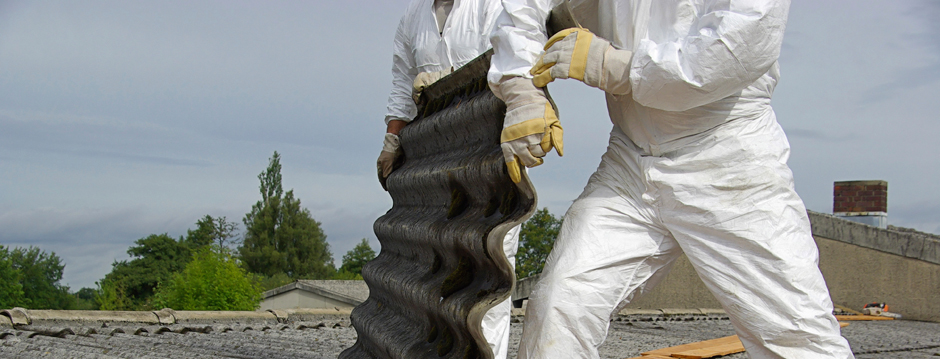
If you discover asbestos to be present - whether in a home or during construction work on a commercial building – the most important thing to remember is that you must not remove it or dispose of it yourself.
Only trained professionals who know how to handle asbestos safely should remove and dispose of the material.
Asbestos becomes harmful once it is disturbed. Unfortunately, the side effects of asbestos inhalation may not become obvious until years after the disturbance. If you suspect asbestos, immediately stop what you're doing, isolate the area, and contact your local council for advice on removal and disposal.
Despite not being able to do any of the asbestos handling yourself, you still need to be aware of the protocol and what happens next. Below is a guide on how to remove and dispose of asbestos.
- Read our guide to asbestos and information on where asbestos can be found in your home.
How to Remove Asbestos
Official government guidance notes asbestos is only dangerous if it is disturbed, so homeowners do not have to worry if it is merely present in a property.
However, it should still be removed ASAP in a controlled manner, by professionals who know what they are doing. In today's DIY-centric world, it is easier than you think to carry out some work and be exposed to asbestos without knowing it.
If concerned about the presence of asbestos, say you're working on an old property built before 2000 and which has had no major renovations, there are ways to protect yourself. PPE should always be worn when carrying out any DIY work, but protective breathing and eye equipment is particularly important in this instance.
When asbestos is mishandled, the fibres can become airborne. So, a professional will understand how to best handle it:
- the room and area must be clear to avoid contamination of furniture and other objects
- anything which can't be removed must be covered with thick polythene sheeting
- the room must be closed off from visitors and non-professionals
- warning signs and barriers will have to be used
- asbestos must be placed into leak-proof disposal containers and sealed
Those dealing with asbestos will have to wear respiratory protection, clothing protection, rubber gloves and eye protection. Every inch of skin will have to be covered, and the protective clothing removed as soon as they exit the containment area after the job is done.
How is asbestos dealt with?
It was once advised that decorators could simply cover asbestos, by wallpapering over it using a very sticky adhesive, or by covering it with gloss paint. This is NOT recommended; please always get asbestos removed, but be aware it can be anywhere on your property.
Waste containing more than 0.1 per cent asbestos is classed as hazardous/special waste. You must deal with this waste as such. Asbestos should be double-bagged and disposed of in a covered skip. If accessible by members of the public, such as on a roadside, this skip must be locked.
You will also need to dispose of any materials which have come into contact with asbestos, such as the clothing and protective equipment worn during the removal. Asbestos waste should not be mixed with any other form of waste. Asbestos waste, and the skip, should clearly be labelled with the asbestos warning signs.
When removed, the waste disposal company which transports asbestos waste must comply with the Carriage of Dangerous Goods Regulations. The skip and waste must be dropped off at dedicated asbestos removal sites; this may not be your most local waste site.
If anyone is concerned about asbestos removal, the government urges them to contact their local council for help.
The importance of choosing the correct asbestos removal company
It is vital you choose a registered company that knows what they are doing. This will not only be the safest option for you, having to use your home or building after the removal, but they can also give you advice on what happens next.
They will also dispose of the asbestos correctly. Illegal waste disposal is a huge issue, so you want to ensure the removal company have a waste disposal note.
Illegal asbestos waste disposal puts the public and non-professionals at risk of exposure, which is dangerous for long-term health.
- 2024
- 2023
- December 2023 (13)
- November 2023 (10)
- October 2023 (6)
- September 2023 (10)
- August 2023 (20)
- July 2023 (21)
- June 2023 (17)
- May 2023 (17)
- April 2023 (17)
- March 2023 (14)
- February 2023 (15)
- January 2023 (7)
- 2022
- December 2022 (6)
- November 2022 (12)
- October 2022 (24)
- September 2022 (14)
- August 2022 (12)
- July 2022 (15)
- June 2022 (18)
- May 2022 (14)
- April 2022 (9)
- March 2022 (5)
- February 2022 (5)
- January 2022 (2)
- 2021
- December 2021 (7)
- November 2021 (10)
- October 2021 (1)
- September 2021 (1)
- August 2021 (3)
- July 2021 (3)
- June 2021 (4)
- May 2021 (1)
- April 2021 (1)
- March 2021 (2)
- February 2021 (1)
- January 2021 (1)
- 2020
- 2019
- 2017
- 2016
- 2014
- 2013
- 2012
- 2011


